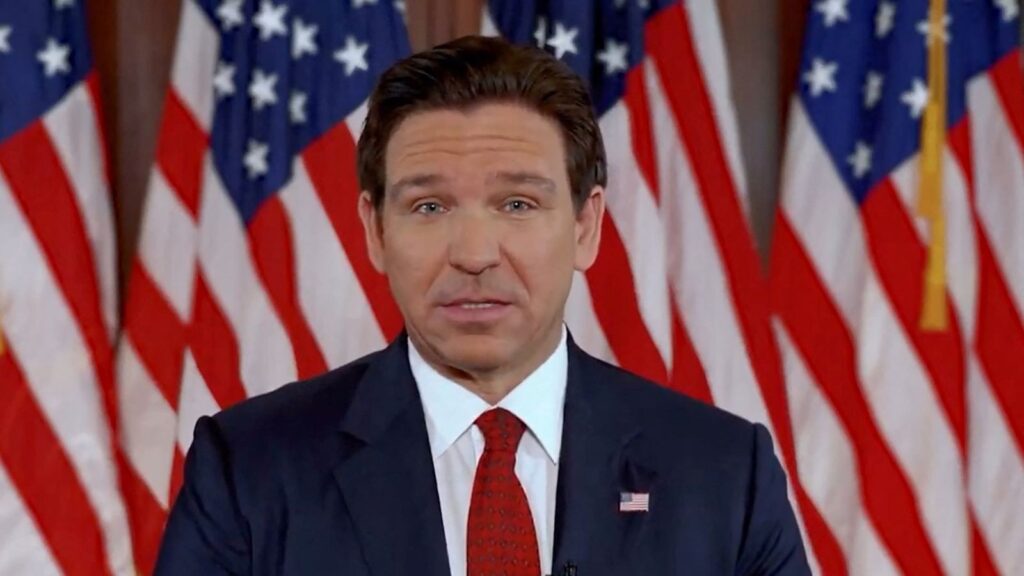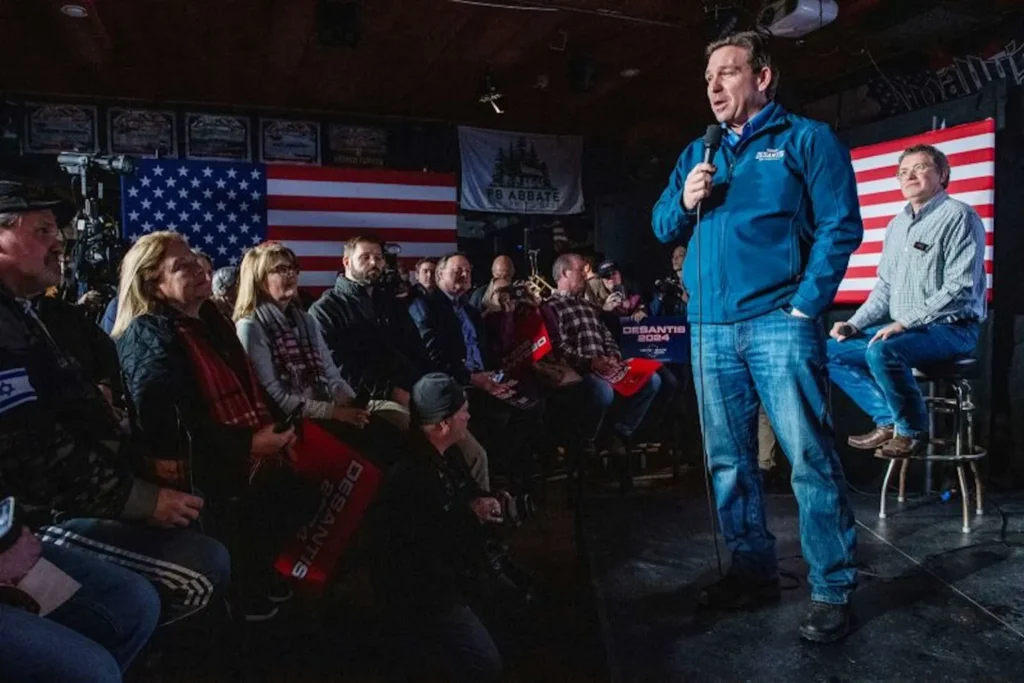Examining the situation: Former rising Republican star Ron DeSantis managed an error-ridden presidential campaign.
The senior advisors to Ron DeSantis prepared for a dismal result in the days preceding the Iowa caucuses. They started thinking about possibilities for the governor of Florida with his political future in mind after months of polls telling them that enough Republicans were prepared to move on from Donald Trump. However, the majority of them were not, according to the predictions.
They laid forth for DeSantis a number of potential results and directions. They said that DeSantis might step out, back the outgoing president, complete his second term as governor, and repair his reputation with an eye toward 2028 in the event that Trump put on a strong show.
A person acquainted with the conversation said that he flatly rejected the notion. That concluded our conversation.
At least that’s what they assumed.
Less than a week after suffering a humiliating defeat in Iowa and only a few days before voters in New Hampshire dealt him yet another setback, Ron DeSantis withdrew from the 2024 presidential contest on Sunday. DeSantis endorsed Trump and said he was willing to serve out his second term as governor in a video address made from Florida.
For a while, it appeared like the Republican leader had a special opportunity to take the party away from Trump, but his resignation was a spectacular downfall for him. With money and power behind him, an impressive resume, a generational argument, and a success story to tell, DeSantis appeared to have it all. He led Trump in a few of the early surveys.
However, he was up against a well-liked former president and had little room for error. Furthermore, as DeSantis’ advisors, allies, and fans have admitted in interviews with CNN, his team made a lot of blunders.
An advisor close to DeSantis stated, “Everything that might not have transpired the way we hoped or anticipated went horribly wrong.”
DeSantis proposed that if Trump was not facing 91 allegations and four indictments from federal and state courts, the campaign may have been different. A number of Trump’s advisors also think that, just as the GOP presidential contest was ready to heat up, Trump’s legal troubles energized Republicans and blocked the path for a challenger. In the next days and weeks, former governor of South Carolina Nikki Haley will attempt to gauge the extent of that vacancy.

- Ron DeSantis’ bid for the Republican presidential nomination in 2024 is over.
DeSantis stated to the Christian Broadcasting Connect in December, “If I might have altered anything, I wish Trump had not been accused of any of this.”
Nevertheless, throughout the course of an eight-month campaign, DeSantis’ team struggled to identify any successful moves, from the terrible and poorly executed original Twitter Spaces commercial featuring Elon Musk to the challenging on-the-ground operation in Iowa. With Trump’s popularity and the icy conditions, an unexpected outcome that would startle the nation is expected.
The decisive error proved to be the last one. Not only did the outcome in Iowa stifle excitement for his candidacy, but it also damaged his reputation. Convinced that his tour of the state’s 99 counties had not been caught by the polls, he had pledged victory there and maintained that his followers would be rewarded for knocking on almost a million doors.
As a matter of fact, Iowa highlighted the complete ineffectiveness of her endeavor, making her candidacy a laughingstock among Republicans and exposing her grassroots tactics, messaging, and strategy like a paper tiger.
“Historic disaster,” remarked a seasoned Republican fundraiser who had previously expressed optimism for DeSantis’ prospects.
Expert Republican strategists Curt Anderson as well as Alex Castellanos dubbed it the “worst Republican presidential candidacy in history” in a scathing analysis they wrote for Politico, which DeSantis’ supporters and detractors equally devoured on Friday.
DeSantis deserves this moniker just as much for the things he wasted as for the things he accomplished.
- ANALYSIS | With Trump leading the Republican Party, America is getting ready for a divisive election.

A sluggish beginning
There was more to DeSantis’ White House candidacy than just the weight of a political campaign.
One close ally put DeSantis’ motivation for running for president as “he believes he is on a mission from God.”
This mindset is encapsulated in his parting statement from his 2022 reelection campaign: A black-and-white video that his wife Casey shared on social media said that DeSantis, who was referred to as “a fighter,” was created by God on the eighth day.
After winning by 19 points in November of that year, some members of the Republican Party were prepared to declare him the heir apparent to President Trump.
The next day, the New York Post proclaimed “DeFuture,” capping two years during which Rupert Murdoch’s media conglomerate showered DeSantis with accolades for his cultural wars and pandemic judgments.
Trump was prepared for the battle, having already declared his candidacy for president once more. As the commotion around DeSantis reached new heights, he labeled his erstwhile buddy a “middle-of-the-road Republican governor” and intensified the attacks from there.
But rather than retaliate, DeSantis, who famously declared he would “never back down from a fight” while sporting a Top Gun outfit, decided against doing so. As an alternative, he concentrated on the Florida legislative session of 2023, outlining a platform of long-desired conservative goals (universal school choice, abortion restrictions that are almost completely banned, and less gun control laws) that would be utilized to further a politically charged presidential campaign. By seizing control of Disney’s special tax district, he also intensified his conflict with the firm over new state regulations on the teaching of gender identity and sexual orientation.
It was only in March that he traveled to Iowa to promote his most recent book. Days later, DeSantis was seen sparring with the former president over an indictment in a New York case involving hush money payments he claimed to have made to adult film star Stormy Daniels. This was his first noteworthy strike at the president.
According to a someone close to the campaign, “the war had started and we were kind of sitting on our butts” during the time when DeSantis was on a book tour across the nation and had not yet made an official campaign announcement. When the governor was being attacked by Trump and his friends, he prevented his team from defending him, and as a result, DeSantis was forced to spend $21 million on advertisements that attempted to characterize him.
In the meantime, DeSantis’ financial funds were turned over to a newly formed super PAC headed by seasoned GOP strategist Jeff Roe and former Trump administration national security official Ken Cuccinelli. A campaign finance watchdog organization noted that the $83 million that the Never Back Down super PAC got from DeSantis’ previous state political committee may have been unlawful, but it nevertheless gave the Republican governor an unheard-of financial edge.
In a novel setup, Never Back Down was requested to manage several responsibilities typically associated with campaigns, such as managing the governor’s events and hiring and training professional pollsters. A revolutionary idea that will transform presidential races forever was offered by Roe and associates.
However, the youthful yet nimble Tallahassee team that had recently guided DeSantis to a historic gubernatorial win clashed with Never Back Down’s team of seasoned political strategists right away. The early conflicts, which the media soon discovered, set the stage for a discontentious summer and autumn that finally resulted in the resignation of a number of high-ranking officials and advisors, including Roe.
- Who is the Florida governor Ron DeSantis, who withdrew from consideration for the US presidency?
Concurrently, the Republican donor class that showered DeSantis with six- and seven-figure payments throughout his reelection campaign abruptly changed their minds. A few voiced their displeasure with his contentious agenda for his second term and his obsession with Disney. Some others desired to test their luck with different candidates from the Republican Party.
DeSantis’ finance staff projected $200 million for the campaign and the super PAC at launching with the intention of raising $500 million for the year, erroneously believing that the boom times would last. Even with the record high sum of $130 million raised by the super PAC by June 30, it was still not enough.
Another fundraiser urged them to choose a name. “Each one of them had been anticipated for them to keep contributing.”
The pullout was minimized at the time by his fundraising team; an individual with knowledge of the situation told CNN that it would only become an issue if Ken Griffin, the owner of a billion-dollar hedge firm that contributed to DeSantis’ reelection, opted not to contribute. They were anticipating $25 million USD from him.
In the end, Griffin gave DeSantis’ White House campaign absolutely nothing.
“If you had explained to me funds would be the issue, I would have advised you you required a psychological checkup,” the donor kept saying. “The general atmosphere that Trump was going to be challenging to bring off was anticipated, yet he anticipated that there would be sufficiently of an entourage who were prepared to contribute to a competitive contender.”
The highest point of Never Back Down’s advertising budget was reached in mid-April, before to DeSantis’s formal entry into the contest.
A poorly executed campaign launch
DeSantis’s whole political campaign was in limbo by the time he was prepared to declare for the election.
According to the fundraiser, “people were feeling like they were facing an uphill battle.”
As per a source acquainted with the procedures, there was a “contentious” discussion among DeSantis’ inner circle over the optimal way to introduce the candidate. Some advocated for a conventional introduction in his hometown of Dunedin, followed by visits to Iowa and New Hampshire. dialogues. Nevertheless, Generra Peck, the woman who would be named DeSantis’ campaign manager, turned down that offer.
An further concept was proposed involving Elon Musk and X, the defunct Twitter account. This ultimately led to the two of them joining forces on Spaces to stream a live announcement. According to a source familiar with the negotiations, proponents of the plan contended that it was a non-traditional advertisement for a non-traditional campaign.
However, supporters and other DeSantis supporters were concerned that with all of the publicity surrounding his campaign, there would not be a video of DeSantis officially declaring his candidacy to air on national television networks. After a settlement was struck, DeSantis discussed his campaign on Fox News as soon as Spaces was released. Musk accepted the concept when it was presented to him via a middleman.
However, during the launch, Musk’s website failed many times, which soon turned into the story of his declaration as a presidential contender.
According to a person with knowledge of the launch, “it could have been great and successful,” but the problem at the top could have been a sign of things to come for the campaign.
When Peck and others attempted to portray DeSantis as having damaged the Internet, the startled donors who had come for the launch at a five-star Miami hotel got even more enraged.
DeSantis continued to operate inside a right-wing media cocoon even as mainstream media coverage of his early gaffes grew. Early on, several aides strongly advocated for DeSantis to engage with national media more; he chose to speak almost entirely to Fox News, conservative radio stations, and right-wing podcasters.
Conversely, DeSantis paid attention to those who were close to him, such as Bryan Griffin and Christina Pushaw, who joined the campaign for him from the governor’s office and urged him to keep shunning the mainstream media. He realizes now that he made the incorrect choice.
In an interview with conservative radio presenter Hugh Hewitt, DeSantis stated, “I came in without generating a lot of commotion in the media.” I ought to have been taking care of everything. I ought to have attended every company event. I ought to have attended every event.”

Problems mount up.
From then on, the irregularities pertaining to DeSantis’ campaign only kept growing.
The campaign’s growth was outpacing its financial means, as was soon evident. Layoffs started to slowly increase in mid-July. DeSantis shifted his attention nearly entirely to Iowa and abandoned his intentions for a national campaign in the meantime.
But according to campaign finance filings, as his campaign came to an end, he spent $1.5 million on private planes through September and hosted extravagant donor retreats at a Park City, Utah, resort, among other destinations.
The disconnect was demonstrated on July 25 by an odd sequence of occurrences. To solicit money, DeSantis took a private jet to Tennessee. His four-car delegation was involved in an accident once they were on the ground, one of the vehicles being driven by the governor. A third of his personnel was sacked by his campaign on the same day. In South Carolina, Never Back Down ran its final advertisement.
Peck was let go two weeks later.
Nevertheless, in the midst of the chaos, DeSantis’ staff—headed by his lead pollster Ryan Tyson—reassured supporters and staff that there was a position available in Iowa. Their polling data indicated an increasing proportion of Republicans who were willing to distance themselves from Trump each time they hit the field. They believed that the former president’s surge of support was only a transient response to his claims.
But the super PAC and the campaign’s advertisements presented a disarray of tactics rather than a cohesive message regarding his candidacy. DeSantis was mostly in charge of wooing Trump supporters in the state by making appearances.
DeSantis found it difficult to provide a convincing defense of his campaign during his tour of 99 Iowa counties, frequently concentrating on his previous achievements as governor rather than his future plans. Repeating language specific to his state and occasionally confusing large groups, he frequently answered queries from Iowans with activities he had performed in Florida.
There were times when his speeches required a glossary of terms for average Republicans to understand: woke, ESG, DEI, CRT, digital currency issued by the Central Bank, social credit scores, Zuckerbucks—all terms, phrases, and acronyms that DeSantis frequently used when making appearances on the campaign trail, in interviews with the media, and in his responses to debates.
Nevertheless, there were moments when it appeared as though DeSantis was going to pick up steam, such as when well-liked Iowa Governor Kim Reynolds gave him an endorsement in November.
However, that evening also provided an insight into his waning campaign.
His involvement was a stunning setback for DeSantis and an unexpected rift from a custom set by his forerunners. That evening, in an electrifying address at a Des Moines event space, he explained his involvement and offered an impassioned support of the conservative governor of Florida.
But when it came time for DeSantis to speak, he went through a fairly standard speech that included many of the same quotes from his six-month tour of the state, as well as a long diatribe about his successes in Florida and the “woke” forces he had vanquished. The woman who staked her political capital to back him was mentioned in passing only a few of times. Despite spending hundreds of hours in the state and meeting thousands of Iowans, he said little that night to imply that he had matured as a politician during his difficult battle for the nomination or that he had learned anything about Iowa or its people. The audience could hardly muster more than a polite ovation at several points.
Reynolds was allowed to engage with fans behind a barrier for ten minutes after leaving the stage, during which he shook hands and accepted pictures.
DeSantis’ shortcomings as a presidential candidate and his broken promises were exposed that night. Even though DeSantis was a tough and unyielding leader, he had trouble commanding a room and was not very good at following through on a strategy. He had enough stamina to spend weeks traveling the state giving speeches, but he frequently gave off the impression that he didn’t care about the audience.
The politician who had appeared to have done everything required to win Iowa—run, spend money, mobilize support—was ultimately unable to win over Iowans.
On the campaign road, DeSantis frequently highlighted important endorsements, but he also recognized their limitations.
In answer to a query concerning Trump’s growing support in South Carolina the day before he announced his campaign suspension, he told journalists in Myrtle Beach, “Iowa Republican establishment lined up behind me, and I came in second.”
And still, DeSantis refuses to shift course in the face of this resounding rejection of his promise to replicate his Florida success across the United States. As he halfheartedly made his way to South Carolina, the general outline of his stump speech remained the same. He addressed the Republicans there and said, “Vote for me because I’ve already accomplished the things you purportedly like.”
Despite losing, DeSantis pledged to keep taking on “woke ideology.”
” as a nation the campaign itself is over, its purpose continued here for Florida,” DeSantis stated as he bid the team farewell. “We are going to continue to demonstrate to our nation how to lead.”




